Nokia Lumia 800 Review - Nokia's Brave New Foray into WP7
by Brian Klug on January 4, 2012 7:00 AM EST- Posted in
- Smartphones
- Nokia
- windows phone 7
- Mobile
- WP7
- Lumia
- Lumia 800
I think it’s important to start out with battery life for two reasons - I end up spending a huge majority of my time doing battery life tests, and in the case of the Lumia 800 much has been written about battery-related issues. The full disclosure is that the Lumia 800 unfortunately does have some rather glaring power and charging related problems. The first Lumia 800 we were sampled suffered from a battery-related problem that caused spontaneous rebooting during use and some charging issues. This was swapped out for another that had the updated release version firmware on it. This second device is the one I spent my majority of time with, although this second device also periodically reboots, though not as much.
The second issue is one that becomes visible when you fully discharge the phone, which naturally we do a lot of while testing battery. If you discharge the phone completely, and then attempt to re-charge, occasionally the phone will go into an endless boot loop, where it powers on, starts WP7, detects that the battery is below its power-off threshold, and shut down. Then the cycle repeats. Ordinarily this isn’t a big deal, but for some reason the PMIC (Qualcomm's PM8058) doesn’t really charge the phone while this is going on. I encountered this once, and even after 3 days of charging couldn’t boot successfully until I did a hard reset with the Nokia triple finger salute. The other minor issue is that if you get the phone into this low power state, sometimes it won’t pull any current to charge the phone. It takes a few attempts and getting the phone into the right pre-boot environment for this to work properly.
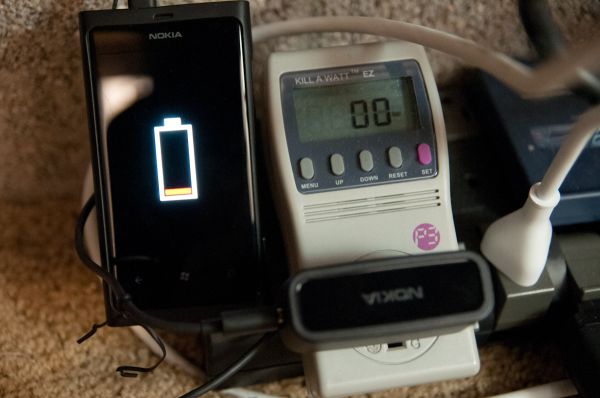 Plugged in but not drawing any current - Unplugging and replugging eventually gets the Lumia 800 to charge correctly and draw 5-6W.
Plugged in but not drawing any current - Unplugging and replugging eventually gets the Lumia 800 to charge correctly and draw 5-6W.
The latest update for the Lumia 800 as of this writing is 1600.2479.7740.11451 and includes “charging improvements” in its change-log, so it’s possible this issue has been addressed already, though there’s another update coming down the line as well. The Lumia 800 we were sampled only was being pushed “1600.2475.7720.11414” due to Microsoft’s staggered update push progress, so again it’s possible this is totally fixed.
There’s a debug menu which can be launched with the dialer code ##634#, and afterwards appears in the normal application list as well. In here you can see the real battery status, charge capacity, and even the instantaneous current draw no doubt as reported by the PMIC. While I wasn’t affected with the bug that sends the charge capacities to 0 mAh, this is still a useful menu.
So the normal corners of our battery life testing are how long the phone lasts while loading pages over 3G and WiFi, and then call time. Page load tests take place with the display set at 200 nits, though on WP7 the only display options are Low, Medium, and High (we selected Medium). We’ve added hotspot tests too which eliminate the display from being a factor, though these aren’t presently able to be tested on WP7.
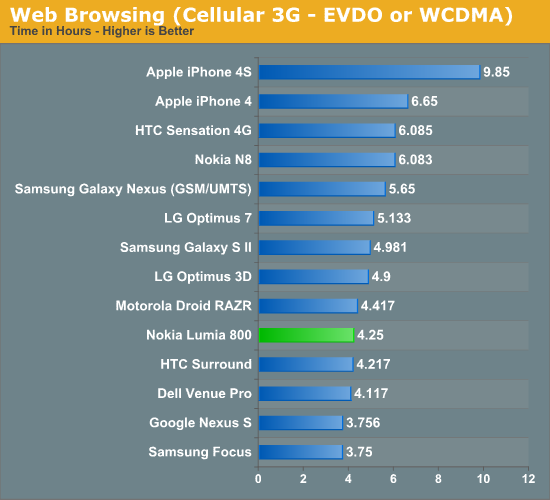
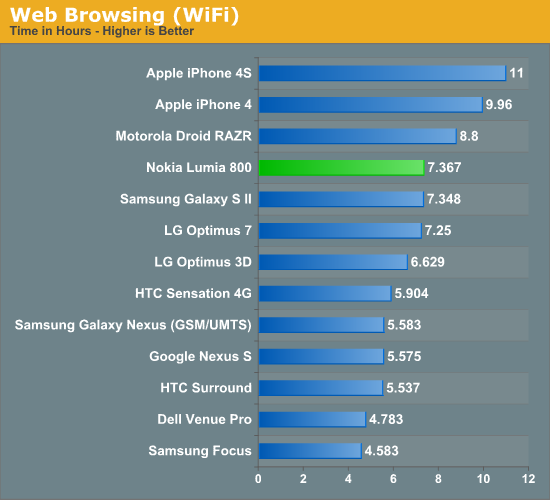
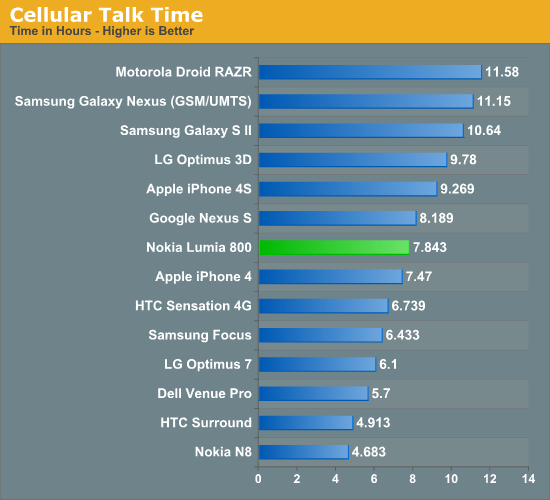
The Lumia leads the pack of WP7 devices we’ve tested in two out of the three categories, but lags the LG Optimus 7 when it comes to loading pages on cellular data. I’m decently impressed with how well the Lumia does considering its 1450mAh (5.37 Whr) battery, yet it could be better. Having an AMOLED display in conjunction with our primarily white background webpages from the page loading suite definitely makes an impact. I can’t help but wonder whether these numbers will improve or not after Nokia also updates firmware and fixes some of the battery life bugs have been publicly acknowledged.
I noticed some other subtle behavior while testing the Lumia 800. A new feature in WP7.5 “mango” is the addition of a battery saver tab under settings which optionally allows automatic pausing of background data and dimming of the display when battery gets low. In this menu you can also view battery percentage and some estimates of battery life remaining based on historical use. With the second updated Lumia 800, the phone turns off at 5%, presumably to mitigate the reboot loop that sometimes results if the phone is discharged to 0%. So there’s at least an extra 5% of battery life hanging around that no doubt will be exposed with the eventual update.


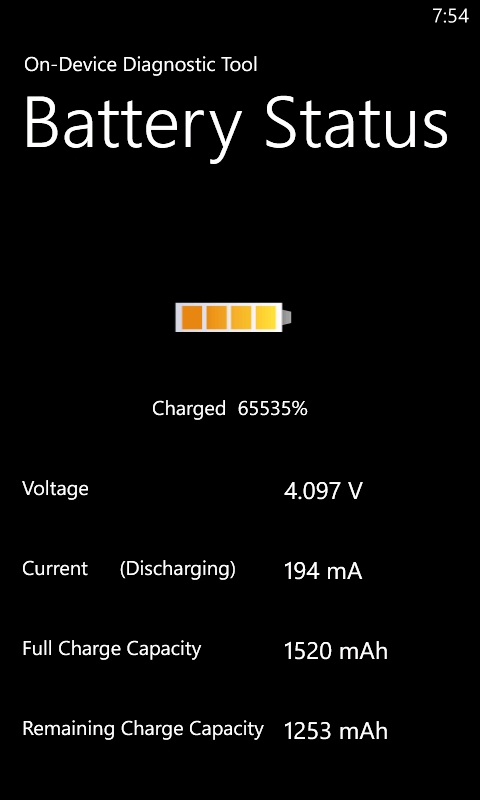
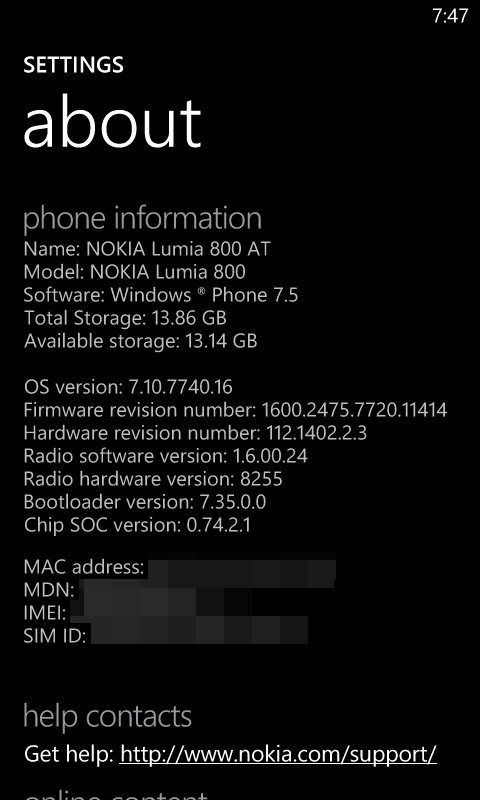
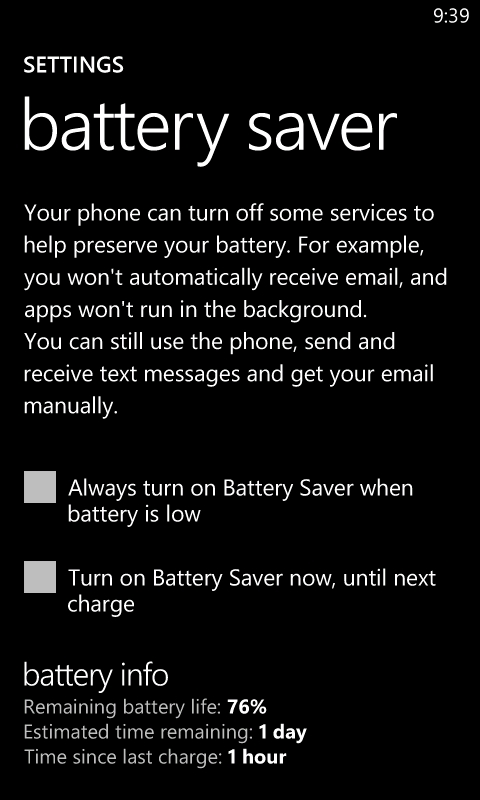








120 Comments
View All Comments
Starfireaw11 - Wednesday, January 4, 2012 - link
For the most part, my Lumia 800 is fast, responsive and smooth. There are a few times where you do notice a bit of a slowdown, but certainly nothing worse than any other phone I've ever come across.A smartphone will always be a balancing act between power consumption, cost and performance, while maintaining a small form-factor. While a Xeon based smartphone would be possible, I don't see one being commercially successful for some reason :D
bplewis24 - Wednesday, January 4, 2012 - link
Android doesn't have bloated applications nor a bloated OS. Troll harder, or become informed as to what you actually speak of.N4g4rok - Wednesday, January 4, 2012 - link
My apologies, i should have specified.Over time, Android will slow down from fragmentation issues, like most OS's, but i've read more complaints recently about older versions of Android.
And unfortunately, due to poor coding, applications will occasionally succumb to memory leaks, further bogging down the OS. Of course killing the application will fix the problem.
It does not make Android inherently bad. It just makes the point that the OS would likely struggle on lower powered single core SoC's that some other phones have.
Penti - Wednesday, January 4, 2012 - link
Making core applications and libraries thread on a dual-core or quad-core SoC is just one way of speeding up some of the slower bits. But that's just a stop gap and just one way of doing it. You could just as easily do improvements for single-core SoC's there as well. Fragmentation actually helps overcome some of this. As the vendors put in improvements and eventually gets Google to redesign or implement new things. Just as you would get an actual NDK for WP at some point and can actually write and port normal applications to that platform. Which isn't trouble free. Which will hit limitations and which will fragment ones phone makers invest some into that platform. Nokia and ST-E will bring in none-Qualcomm hardware. They will bring in core alterations to the software and platform and eventually as it has already proven it will be hard to maintain everything.Just remember WP7 didn't even get sockets until Mango. Stuff like Spotify was ready for MeeGo at pretty much when Nokia released a device and released before Mango got it's client. Just because it got another model to paint stuff on the screen doesn't mean it is superior. Of course poor launchers can destroy a phone, but that is not where it's heading at with many of the vendors having already improved on that. Just look in another year and you will see a whole different market with dual-core being the standard platform driving WP. It took a year to even get basic applications on there... The development kit hasn't been proven as good as advertised by astroturfers. Nobody will make a business on a platform where you can sit and wait a year for even features 10 year old feature phones had.
N4g4rok - Wednesday, January 4, 2012 - link
I agree with that, and i do not mean to insist that WP7 is or will be superior to anything else.The options and large market share that Android offers makes it extremely attractive to multiple vendors, and on top of that, it's flexibility as a development platform is the icing on the cake. Combine that with Google's monitoring of software compatibilities and updating to suit, you end up with a solid, stable platform, just like their most recent releases are shaping up to be.
WP7 has neither of those qualities just yet. Although Microsoft may move in that direction with future releases,but they're taking their time to do it. Taking the time to ensure hardware compatibility is great, but like you mentioned, taking too long getting it up to speed will achieve nothing other than wasting a lot of time and money.
crispbp04 - Wednesday, January 4, 2012 - link
Look at the pot calling the kettle black.doubledeej - Thursday, January 5, 2012 - link
I've had two different top-of-the-line Android phones and they were both horribly slow and liked to stutter constantly. It was very annoying. I switched to WP7 and haven't looked back.steven75 - Wednesday, January 4, 2012 - link
"I've had the device for about a month now and I have to agree with everything that has been said in this article - I'm really happy with it and it's a huge improvement over the iOS,"Except the review doesn't say this. It basically points out that WP7 Mango is where iOS and Android were a year ago.
crispbp04 - Wednesday, January 4, 2012 - link
Weak editorial. I lol'd at "fledgling application ecosystem".Spivonious - Wednesday, January 4, 2012 - link
Yeah, aren't there like 200,000 apps now? All of the needed ones are there.I've been very impressed with WP7 Mango. The fact is that you don't need apps because lots of functionality is built in. People hub gets you Facebook, Twitter, LinkedIn, as well as standard contact info and links to send texts, IMs, emails, post on walls, etc. The Messaging hub combines texting, IM, and emails, grouped by the person you're conversing with. The Xbox hub places all of your games in one place. The Music+Video hub places all of your media and media-watching apps in one place. Bing Search combines web search, Sound Hound, Google Goggles, and Yelp.
And live tiles on the main screen let me see what I'm looking for without opening an app.
The strength of WP7 is the integration of services in one place. It's perfect for the average consumer.